Analyzing Human Motivation: A Study of Maslow's Hierarchy of Needs
VerifiedAdded on 2023/05/30
|6
|1491
|153
Essay
AI Summary
This essay delves into Abraham Maslow's Hierarchy of Needs, a theory proposed in 1943 to explain human motivation. The theory outlines five levels of needs, arranged hierarchically: physiological, safety, love and belonging, esteem, and self-actualization. Physiological needs are the most basic, including requirements for survival like food and water. Safety needs involve security and protection from harm. Love and belonging needs relate to social connections and relationships. Esteem needs encompass feelings of respect and self-worth, and self-actualization represents the desire to achieve one's full potential. The essay discusses each level in detail, highlighting their importance in motivating human behavior. While the theory has faced criticisms regarding the rigidity of the hierarchy and cultural differences, it remains a fundamental concept in understanding human motivation. Desklib offers this and many other solved assignments for students.
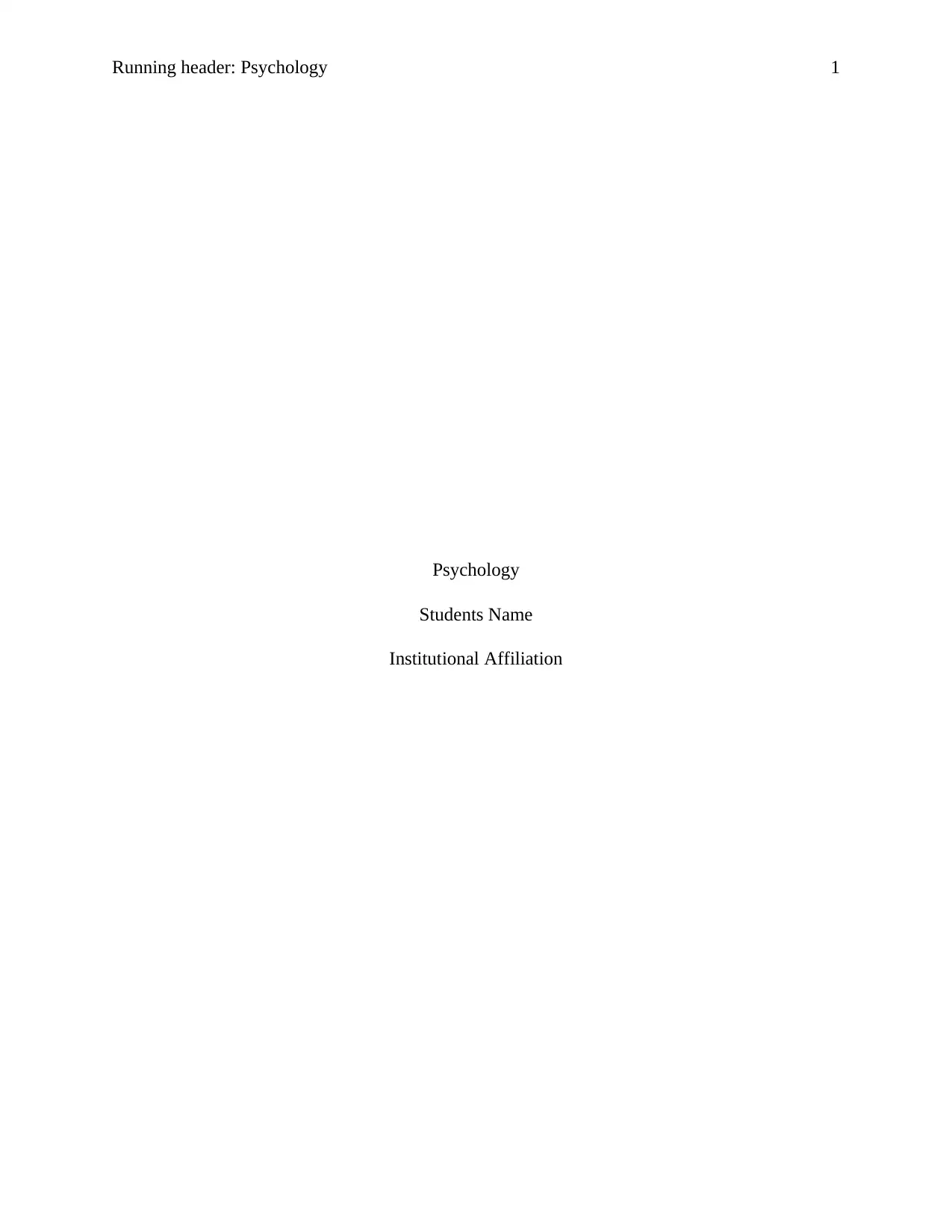
Running header: Psychology 1
Psychology
Students Name
Institutional Affiliation
Psychology
Students Name
Institutional Affiliation
Paraphrase This Document
Need a fresh take? Get an instant paraphrase of this document with our AI Paraphraser
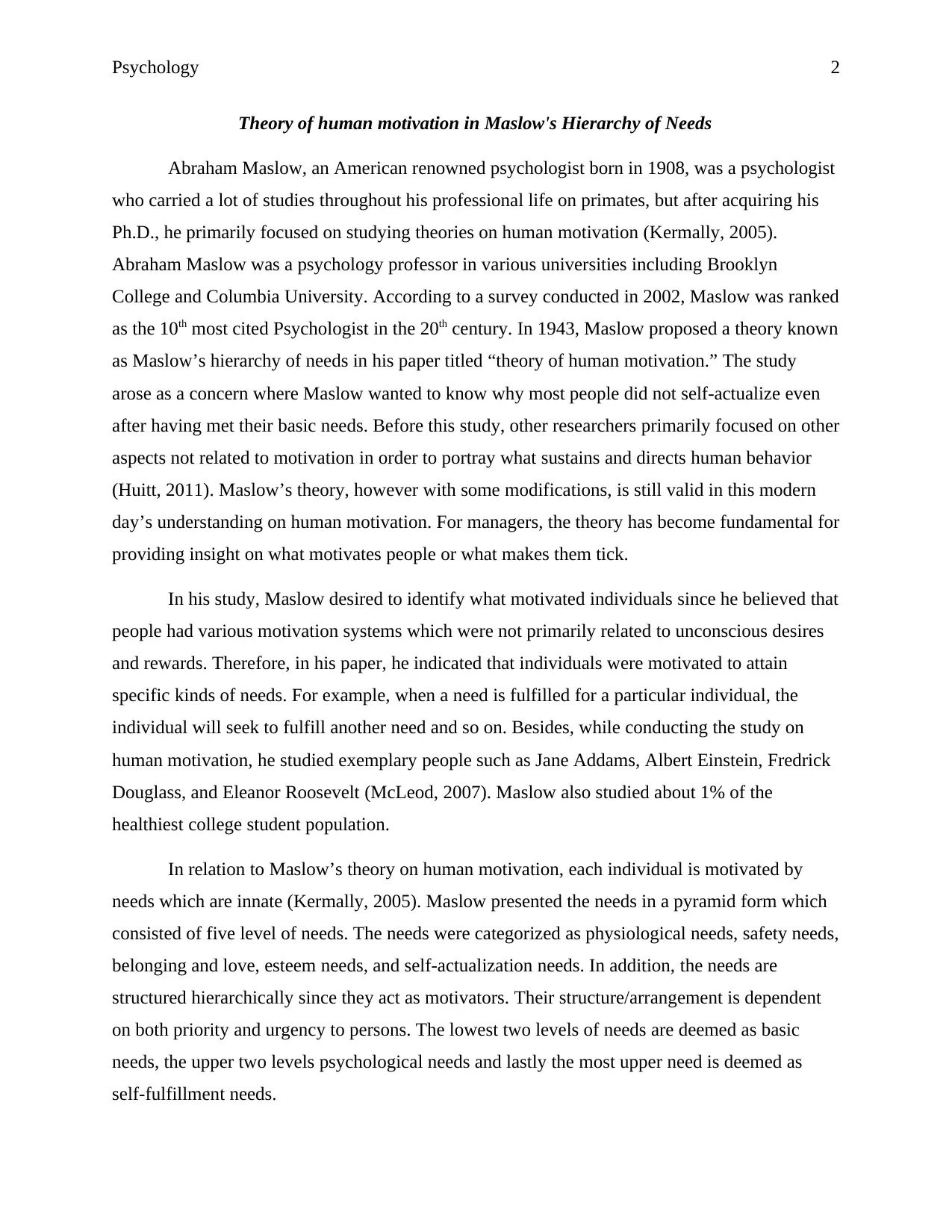
Psychology 2
Theory of human motivation in Maslow's Hierarchy of Needs
Abraham Maslow, an American renowned psychologist born in 1908, was a psychologist
who carried a lot of studies throughout his professional life on primates, but after acquiring his
Ph.D., he primarily focused on studying theories on human motivation (Kermally, 2005).
Abraham Maslow was a psychology professor in various universities including Brooklyn
College and Columbia University. According to a survey conducted in 2002, Maslow was ranked
as the 10th most cited Psychologist in the 20th century. In 1943, Maslow proposed a theory known
as Maslow’s hierarchy of needs in his paper titled “theory of human motivation.” The study
arose as a concern where Maslow wanted to know why most people did not self-actualize even
after having met their basic needs. Before this study, other researchers primarily focused on other
aspects not related to motivation in order to portray what sustains and directs human behavior
(Huitt, 2011). Maslow’s theory, however with some modifications, is still valid in this modern
day’s understanding on human motivation. For managers, the theory has become fundamental for
providing insight on what motivates people or what makes them tick.
In his study, Maslow desired to identify what motivated individuals since he believed that
people had various motivation systems which were not primarily related to unconscious desires
and rewards. Therefore, in his paper, he indicated that individuals were motivated to attain
specific kinds of needs. For example, when a need is fulfilled for a particular individual, the
individual will seek to fulfill another need and so on. Besides, while conducting the study on
human motivation, he studied exemplary people such as Jane Addams, Albert Einstein, Fredrick
Douglass, and Eleanor Roosevelt (McLeod, 2007). Maslow also studied about 1% of the
healthiest college student population.
In relation to Maslow’s theory on human motivation, each individual is motivated by
needs which are innate (Kermally, 2005). Maslow presented the needs in a pyramid form which
consisted of five level of needs. The needs were categorized as physiological needs, safety needs,
belonging and love, esteem needs, and self-actualization needs. In addition, the needs are
structured hierarchically since they act as motivators. Their structure/arrangement is dependent
on both priority and urgency to persons. The lowest two levels of needs are deemed as basic
needs, the upper two levels psychological needs and lastly the most upper need is deemed as
self-fulfillment needs.
Theory of human motivation in Maslow's Hierarchy of Needs
Abraham Maslow, an American renowned psychologist born in 1908, was a psychologist
who carried a lot of studies throughout his professional life on primates, but after acquiring his
Ph.D., he primarily focused on studying theories on human motivation (Kermally, 2005).
Abraham Maslow was a psychology professor in various universities including Brooklyn
College and Columbia University. According to a survey conducted in 2002, Maslow was ranked
as the 10th most cited Psychologist in the 20th century. In 1943, Maslow proposed a theory known
as Maslow’s hierarchy of needs in his paper titled “theory of human motivation.” The study
arose as a concern where Maslow wanted to know why most people did not self-actualize even
after having met their basic needs. Before this study, other researchers primarily focused on other
aspects not related to motivation in order to portray what sustains and directs human behavior
(Huitt, 2011). Maslow’s theory, however with some modifications, is still valid in this modern
day’s understanding on human motivation. For managers, the theory has become fundamental for
providing insight on what motivates people or what makes them tick.
In his study, Maslow desired to identify what motivated individuals since he believed that
people had various motivation systems which were not primarily related to unconscious desires
and rewards. Therefore, in his paper, he indicated that individuals were motivated to attain
specific kinds of needs. For example, when a need is fulfilled for a particular individual, the
individual will seek to fulfill another need and so on. Besides, while conducting the study on
human motivation, he studied exemplary people such as Jane Addams, Albert Einstein, Fredrick
Douglass, and Eleanor Roosevelt (McLeod, 2007). Maslow also studied about 1% of the
healthiest college student population.
In relation to Maslow’s theory on human motivation, each individual is motivated by
needs which are innate (Kermally, 2005). Maslow presented the needs in a pyramid form which
consisted of five level of needs. The needs were categorized as physiological needs, safety needs,
belonging and love, esteem needs, and self-actualization needs. In addition, the needs are
structured hierarchically since they act as motivators. Their structure/arrangement is dependent
on both priority and urgency to persons. The lowest two levels of needs are deemed as basic
needs, the upper two levels psychological needs and lastly the most upper need is deemed as
self-fulfillment needs.
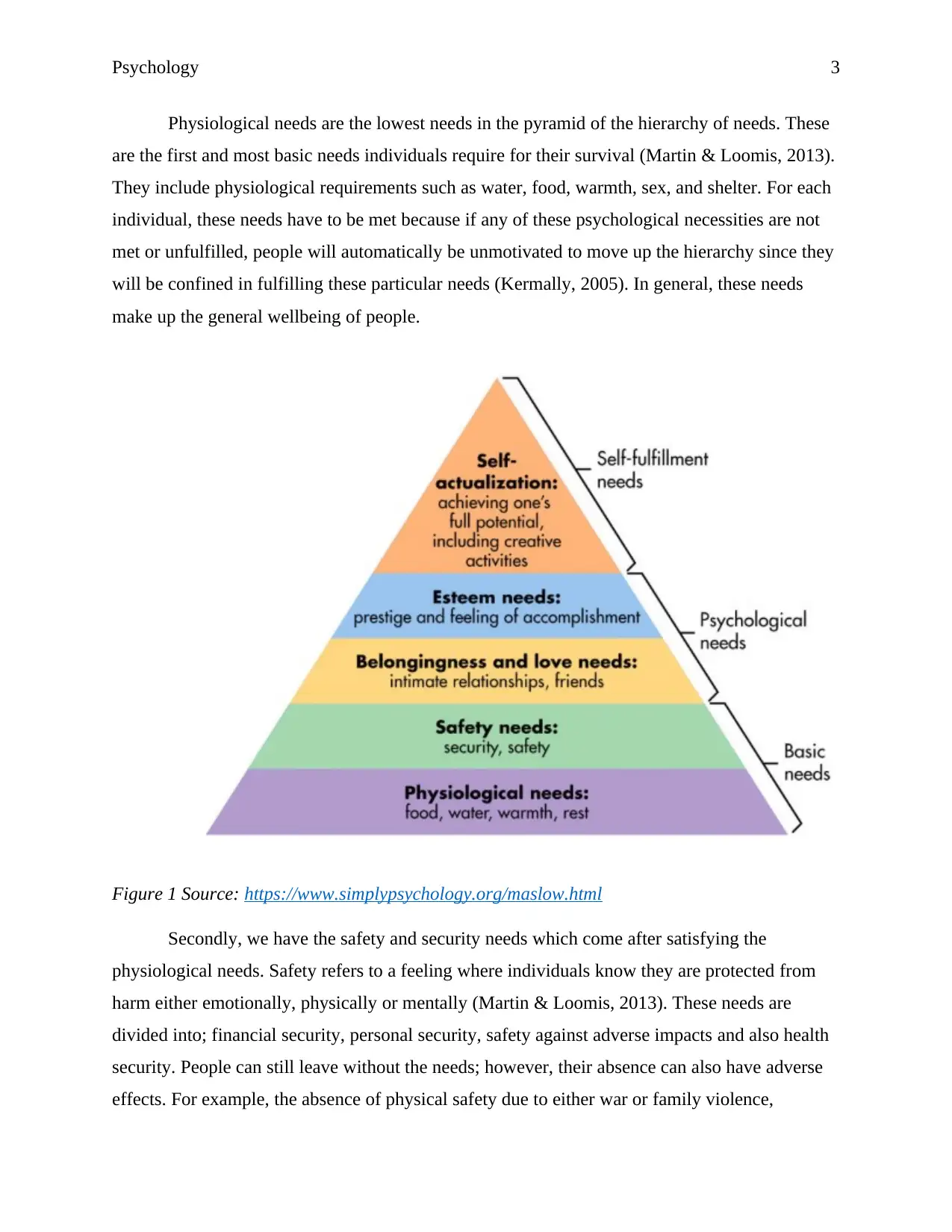
Psychology 3
Physiological needs are the lowest needs in the pyramid of the hierarchy of needs. These
are the first and most basic needs individuals require for their survival (Martin & Loomis, 2013).
They include physiological requirements such as water, food, warmth, sex, and shelter. For each
individual, these needs have to be met because if any of these psychological necessities are not
met or unfulfilled, people will automatically be unmotivated to move up the hierarchy since they
will be confined in fulfilling these particular needs (Kermally, 2005). In general, these needs
make up the general wellbeing of people.
Figure 1 Source: https://www.simplypsychology.org/maslow.html
Secondly, we have the safety and security needs which come after satisfying the
physiological needs. Safety refers to a feeling where individuals know they are protected from
harm either emotionally, physically or mentally (Martin & Loomis, 2013). These needs are
divided into; financial security, personal security, safety against adverse impacts and also health
security. People can still leave without the needs; however, their absence can also have adverse
effects. For example, the absence of physical safety due to either war or family violence,
Physiological needs are the lowest needs in the pyramid of the hierarchy of needs. These
are the first and most basic needs individuals require for their survival (Martin & Loomis, 2013).
They include physiological requirements such as water, food, warmth, sex, and shelter. For each
individual, these needs have to be met because if any of these psychological necessities are not
met or unfulfilled, people will automatically be unmotivated to move up the hierarchy since they
will be confined in fulfilling these particular needs (Kermally, 2005). In general, these needs
make up the general wellbeing of people.
Figure 1 Source: https://www.simplypsychology.org/maslow.html
Secondly, we have the safety and security needs which come after satisfying the
physiological needs. Safety refers to a feeling where individuals know they are protected from
harm either emotionally, physically or mentally (Martin & Loomis, 2013). These needs are
divided into; financial security, personal security, safety against adverse impacts and also health
security. People can still leave without the needs; however, their absence can also have adverse
effects. For example, the absence of physical safety due to either war or family violence,
⊘ This is a preview!⊘
Do you want full access?
Subscribe today to unlock all pages.

Trusted by 1+ million students worldwide
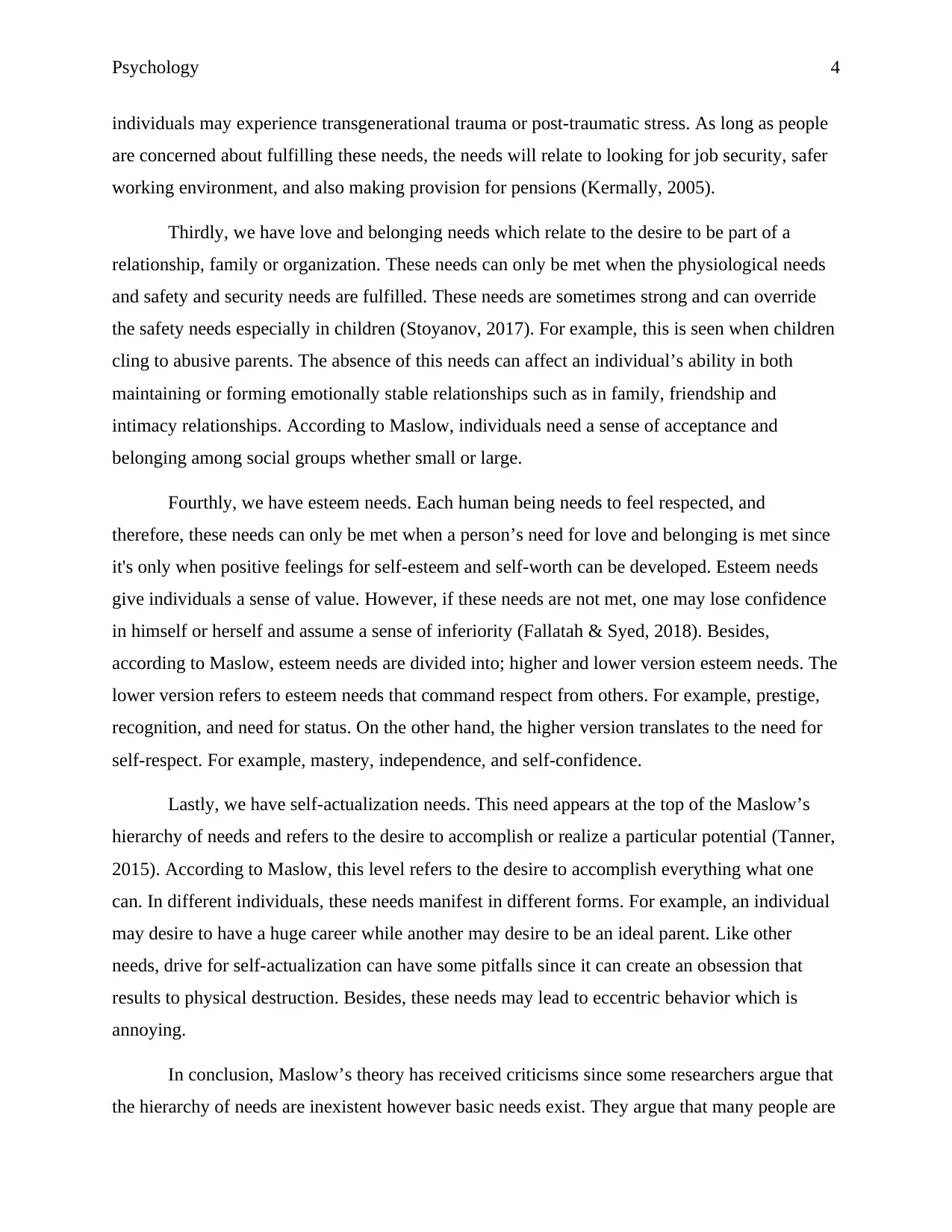
Psychology 4
individuals may experience transgenerational trauma or post-traumatic stress. As long as people
are concerned about fulfilling these needs, the needs will relate to looking for job security, safer
working environment, and also making provision for pensions (Kermally, 2005).
Thirdly, we have love and belonging needs which relate to the desire to be part of a
relationship, family or organization. These needs can only be met when the physiological needs
and safety and security needs are fulfilled. These needs are sometimes strong and can override
the safety needs especially in children (Stoyanov, 2017). For example, this is seen when children
cling to abusive parents. The absence of this needs can affect an individual’s ability in both
maintaining or forming emotionally stable relationships such as in family, friendship and
intimacy relationships. According to Maslow, individuals need a sense of acceptance and
belonging among social groups whether small or large.
Fourthly, we have esteem needs. Each human being needs to feel respected, and
therefore, these needs can only be met when a person’s need for love and belonging is met since
it's only when positive feelings for self-esteem and self-worth can be developed. Esteem needs
give individuals a sense of value. However, if these needs are not met, one may lose confidence
in himself or herself and assume a sense of inferiority (Fallatah & Syed, 2018). Besides,
according to Maslow, esteem needs are divided into; higher and lower version esteem needs. The
lower version refers to esteem needs that command respect from others. For example, prestige,
recognition, and need for status. On the other hand, the higher version translates to the need for
self-respect. For example, mastery, independence, and self-confidence.
Lastly, we have self-actualization needs. This need appears at the top of the Maslow’s
hierarchy of needs and refers to the desire to accomplish or realize a particular potential (Tanner,
2015). According to Maslow, this level refers to the desire to accomplish everything what one
can. In different individuals, these needs manifest in different forms. For example, an individual
may desire to have a huge career while another may desire to be an ideal parent. Like other
needs, drive for self-actualization can have some pitfalls since it can create an obsession that
results to physical destruction. Besides, these needs may lead to eccentric behavior which is
annoying.
In conclusion, Maslow’s theory has received criticisms since some researchers argue that
the hierarchy of needs are inexistent however basic needs exist. They argue that many people are
individuals may experience transgenerational trauma or post-traumatic stress. As long as people
are concerned about fulfilling these needs, the needs will relate to looking for job security, safer
working environment, and also making provision for pensions (Kermally, 2005).
Thirdly, we have love and belonging needs which relate to the desire to be part of a
relationship, family or organization. These needs can only be met when the physiological needs
and safety and security needs are fulfilled. These needs are sometimes strong and can override
the safety needs especially in children (Stoyanov, 2017). For example, this is seen when children
cling to abusive parents. The absence of this needs can affect an individual’s ability in both
maintaining or forming emotionally stable relationships such as in family, friendship and
intimacy relationships. According to Maslow, individuals need a sense of acceptance and
belonging among social groups whether small or large.
Fourthly, we have esteem needs. Each human being needs to feel respected, and
therefore, these needs can only be met when a person’s need for love and belonging is met since
it's only when positive feelings for self-esteem and self-worth can be developed. Esteem needs
give individuals a sense of value. However, if these needs are not met, one may lose confidence
in himself or herself and assume a sense of inferiority (Fallatah & Syed, 2018). Besides,
according to Maslow, esteem needs are divided into; higher and lower version esteem needs. The
lower version refers to esteem needs that command respect from others. For example, prestige,
recognition, and need for status. On the other hand, the higher version translates to the need for
self-respect. For example, mastery, independence, and self-confidence.
Lastly, we have self-actualization needs. This need appears at the top of the Maslow’s
hierarchy of needs and refers to the desire to accomplish or realize a particular potential (Tanner,
2015). According to Maslow, this level refers to the desire to accomplish everything what one
can. In different individuals, these needs manifest in different forms. For example, an individual
may desire to have a huge career while another may desire to be an ideal parent. Like other
needs, drive for self-actualization can have some pitfalls since it can create an obsession that
results to physical destruction. Besides, these needs may lead to eccentric behavior which is
annoying.
In conclusion, Maslow’s theory has received criticisms since some researchers argue that
the hierarchy of needs are inexistent however basic needs exist. They argue that many people are
Paraphrase This Document
Need a fresh take? Get an instant paraphrase of this document with our AI Paraphraser
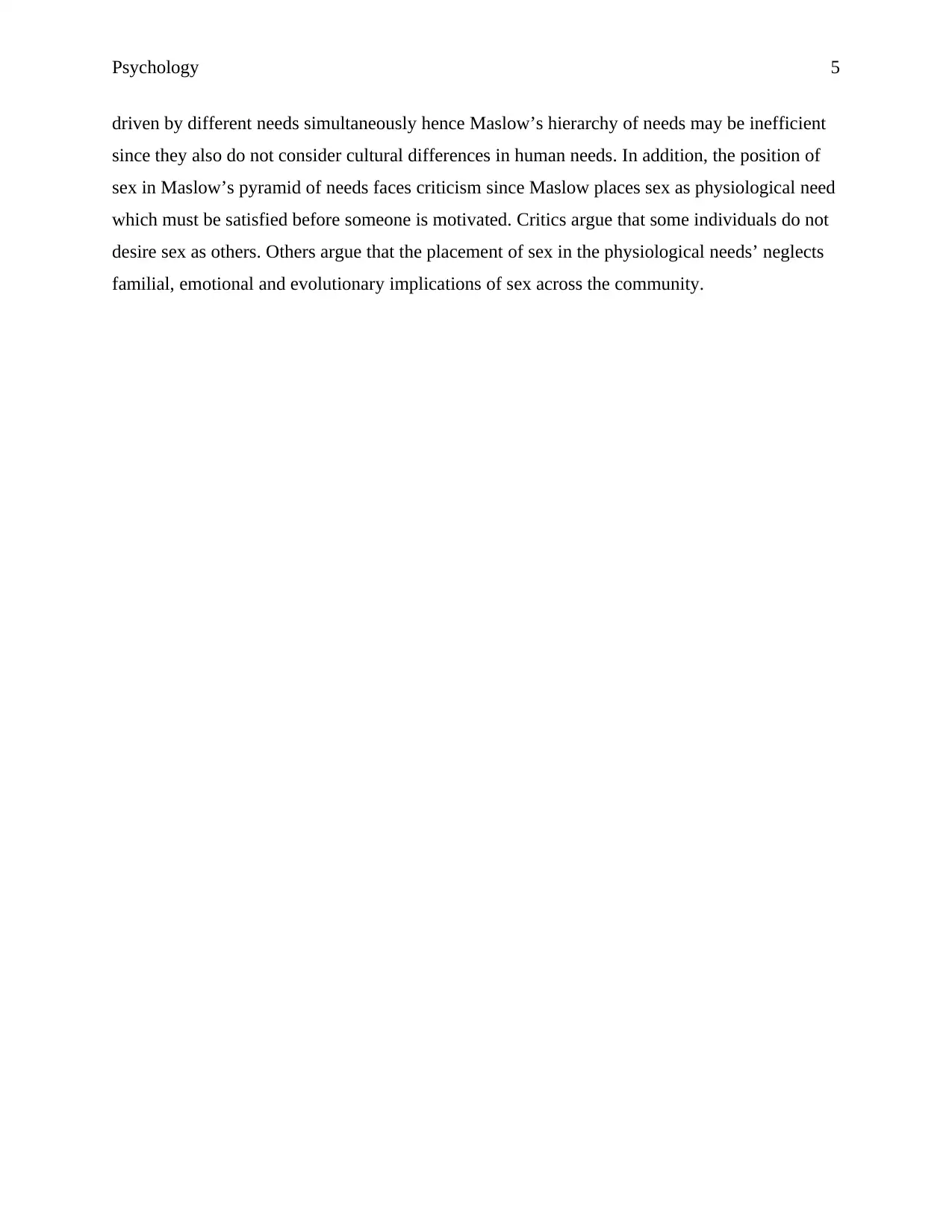
Psychology 5
driven by different needs simultaneously hence Maslow’s hierarchy of needs may be inefficient
since they also do not consider cultural differences in human needs. In addition, the position of
sex in Maslow’s pyramid of needs faces criticism since Maslow places sex as physiological need
which must be satisfied before someone is motivated. Critics argue that some individuals do not
desire sex as others. Others argue that the placement of sex in the physiological needs’ neglects
familial, emotional and evolutionary implications of sex across the community.
driven by different needs simultaneously hence Maslow’s hierarchy of needs may be inefficient
since they also do not consider cultural differences in human needs. In addition, the position of
sex in Maslow’s pyramid of needs faces criticism since Maslow places sex as physiological need
which must be satisfied before someone is motivated. Critics argue that some individuals do not
desire sex as others. Others argue that the placement of sex in the physiological needs’ neglects
familial, emotional and evolutionary implications of sex across the community.
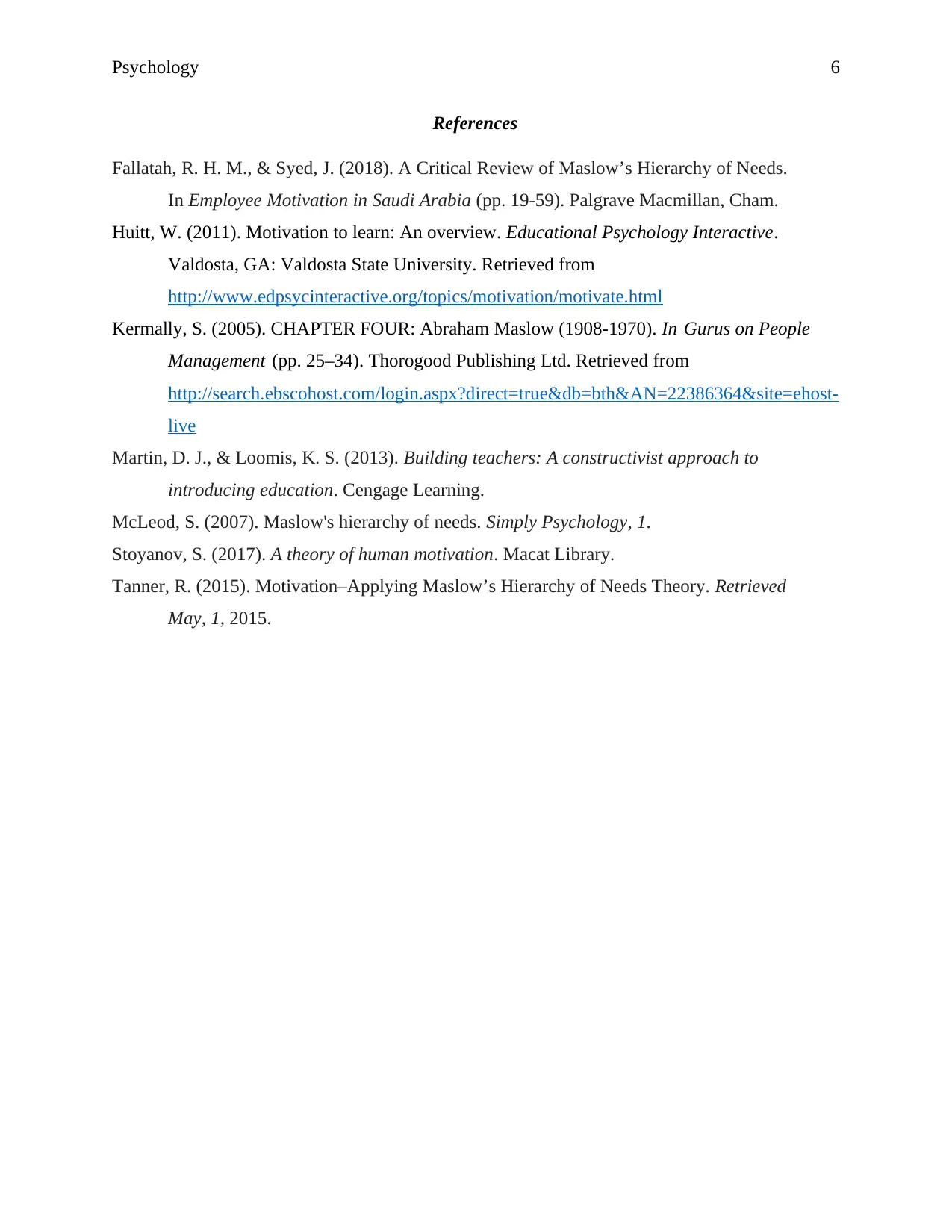
Psychology 6
References
Fallatah, R. H. M., & Syed, J. (2018). A Critical Review of Maslow’s Hierarchy of Needs.
In Employee Motivation in Saudi Arabia (pp. 19-59). Palgrave Macmillan, Cham.
Huitt, W. (2011). Motivation to learn: An overview. Educational Psychology Interactive.
Valdosta, GA: Valdosta State University. Retrieved from
http://www.edpsycinteractive.org/topics/motivation/motivate.html
Kermally, S. (2005). CHAPTER FOUR: Abraham Maslow (1908-1970). In Gurus on People
Management (pp. 25–34). Thorogood Publishing Ltd. Retrieved from
http://search.ebscohost.com/login.aspx?direct=true&db=bth&AN=22386364&site=ehost-
live
Martin, D. J., & Loomis, K. S. (2013). Building teachers: A constructivist approach to
introducing education. Cengage Learning.
McLeod, S. (2007). Maslow's hierarchy of needs. Simply Psychology, 1.
Stoyanov, S. (2017). A theory of human motivation. Macat Library.
Tanner, R. (2015). Motivation–Applying Maslow’s Hierarchy of Needs Theory. Retrieved
May, 1, 2015.
References
Fallatah, R. H. M., & Syed, J. (2018). A Critical Review of Maslow’s Hierarchy of Needs.
In Employee Motivation in Saudi Arabia (pp. 19-59). Palgrave Macmillan, Cham.
Huitt, W. (2011). Motivation to learn: An overview. Educational Psychology Interactive.
Valdosta, GA: Valdosta State University. Retrieved from
http://www.edpsycinteractive.org/topics/motivation/motivate.html
Kermally, S. (2005). CHAPTER FOUR: Abraham Maslow (1908-1970). In Gurus on People
Management (pp. 25–34). Thorogood Publishing Ltd. Retrieved from
http://search.ebscohost.com/login.aspx?direct=true&db=bth&AN=22386364&site=ehost-
live
Martin, D. J., & Loomis, K. S. (2013). Building teachers: A constructivist approach to
introducing education. Cengage Learning.
McLeod, S. (2007). Maslow's hierarchy of needs. Simply Psychology, 1.
Stoyanov, S. (2017). A theory of human motivation. Macat Library.
Tanner, R. (2015). Motivation–Applying Maslow’s Hierarchy of Needs Theory. Retrieved
May, 1, 2015.
⊘ This is a preview!⊘
Do you want full access?
Subscribe today to unlock all pages.

Trusted by 1+ million students worldwide
1 out of 6
Related Documents
Your All-in-One AI-Powered Toolkit for Academic Success.
+13062052269
info@desklib.com
Available 24*7 on WhatsApp / Email
![[object Object]](/_next/static/media/star-bottom.7253800d.svg)
Unlock your academic potential
Copyright © 2020–2025 A2Z Services. All Rights Reserved. Developed and managed by ZUCOL.





